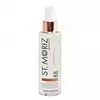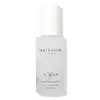St. Moriz Advanced Pro Formula Radiant Glow Face Mist Versus Dolce Glow Acqua Hydrating Self-Tanning Face Mist
What's inside
What's inside
 Key Ingredients
Key Ingredients

 Benefits
Benefits

 Concerns
Concerns

 Ingredients Side-by-side
Ingredients Side-by-side

Water
Skin ConditioningDihydroxyacetone
Skin ConditioningAloe Barbadensis Leaf Juice
Skin ConditioningDimethyl Isosorbide
SolventCamellia Sinensis Leaf Extract
AntimicrobialVaccinium Macrocarpon Fruit Extract
AstringentSimmondsia Chinensis Seed Oil
EmollientMacadamia Integrifolia Seed Oil
Skin ConditioningSaccharum Officinarum Extract
MoisturisingCaffeine
Skin ConditioningTocopherol
AntioxidantPolysorbate 20
EmulsifyingErythrulose
TanningSodium Hyaluronate
HumectantPanthenol
Skin ConditioningGlycerin
HumectantPhenoxyethanol
PreservativeMaltodextrin
AbsorbentAlcohol
AntimicrobialCitronellol
PerfumingHexyl Cinnamal
PerfumingButylphenyl Methylpropional
PerfumingMethyl Ionones
MaskingWater, Dihydroxyacetone, Aloe Barbadensis Leaf Juice, Dimethyl Isosorbide, Camellia Sinensis Leaf Extract, Vaccinium Macrocarpon Fruit Extract, Simmondsia Chinensis Seed Oil, Macadamia Integrifolia Seed Oil, Saccharum Officinarum Extract, Caffeine, Tocopherol, Polysorbate 20, Erythrulose, Sodium Hyaluronate, Panthenol, Glycerin, Phenoxyethanol, Maltodextrin, Alcohol, Citronellol, Hexyl Cinnamal, Butylphenyl Methylpropional, Methyl Ionones
Ingredients Explained
These ingredients are found in both products.
Ingredients higher up in an ingredient list are typically present in a larger amount.
Dihydroxyacetone, or DHA, is a simple sugar. It is frequently used in self-tanning products.
DHA binds to the amino acids in your dead skin cells to create a brown/orange color. Darkening begins to kick in a few hours after application and will continue to develop for up to 3 days. This ingredient can be drying.
Both the US and the EU have approved DHA in self-tanning products. In the EU, DHA is allowed at a maximum concentration of 10%. Most tanning products usually contain amounts between 3-5%.
If you are pregnant or have underlying medical conditions, it is best to speak with a dermatologist about using self-tanning products.
Learn more about DihydroxyacetonePhenoxyethanol is a preservative that has germicide, antimicrobial, and aromatic properties. Studies show that phenoxyethanol can prevent microbial growth. By itself, it has a scent that is similar to that of a rose.
It's often used in formulations along with Caprylyl Glycol to preserve the shelf life of products.
Water. It's the most common cosmetic ingredient of all. You'll usually see it at the top of ingredient lists, meaning that it makes up the largest part of the product.
So why is it so popular? Water most often acts as a solvent - this means that it helps dissolve other ingredients into the formulation.
You'll also recognize water as that liquid we all need to stay alive. If you see this, drink a glass of water. Stay hydrated!
Learn more about Water